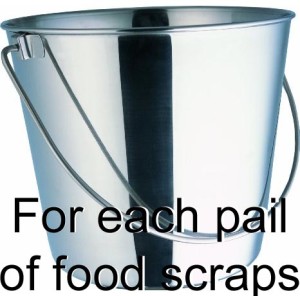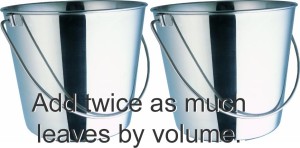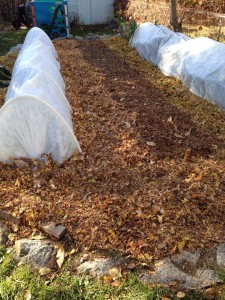People often ask how many leaves they should save for their compost pile. It’s the right question to ask, because when making compost if you strike the correct balance of leaves and nitrogen-rich food scraps, you’ll get rich, light, sweet-smelling compost. Get it wrong and your compost may stink terribly or be very slow to decompose.

For each container of food scraps or coffee grounds.

Add twice as many leaves by volume.
So, how many leaves do you need to stockpile to make compost?
The answer: Enough to fill your compost container. Really.
Each time you add food scraps, add two or three times as much (by volume) leaves. One bucket from the kitchen? Add two or three buckets of leaves. (No, you don’t need to use your bucket, just grab some handfuls or shovels-full of leaves until you’ve got the equivalent of two or three buckets.)
As you add material the pile will grow, but it will also shrink, by 1/3 to 1/2, as the material decomposes. By the time you fill your bin, you will use approximately one bin-worth of leaves.
Most people find it easiest to keep leaves right next to your compost pile. If you can shred them in the fall and place them next to your bin for easy access, that’s great. Either in a bag, a separate container, or set up some chicken wire in a cylinder shape – having them within arm’s reach is very convenient, especially if it is cold or rainy.
Now comes the “nothing is ever that simple” part: Not all leaves are created equal. Some common New England tree leaves like maple, butternut, birch, and black cherry, will decompose quickly and easily. Others, like oak and pine, contain more lignin and will decompose slower. Pine needles should only be added in limited quantities due to their acidic qualities UNLESS you plan to make compost for acid-loving plants like blueberries, azaleas, holly or, of course, a pine tree. EDIT: Pine needles, once decomposed, are not acidic.
All leaves decompose faster if shredded with a lawnmower or leaf shredder and are very helpful in making a “hot” compost.

Shredded leaves keep soil in place, add nutrients to the soil and make a great, soft path material to keep weeds down. You can even alternate leaf-variety for patterns.
Added bonus: You can use your leaves as mulch if you shred them first. Shredded leaves stay in place, don’t form an impenetrable mat, and look attractive. They also help the soil retain water and, as they break down, provide their nutrients back to the soil. I also use shredded leaves for pathways and cover my vegetable garden beds with them over winter to feed the worms and keep nutrients (and top soil) in place. I prefer to put slow-decomposers like oak leaves in flower beds and pathways, where their slower decomposition is helpful, and not in the vegetable gardens. As an added bonus, using shredded leaves means you’re not contributing to cypress forest destruction to mulch your plants.
So in the fall (or spring, if you’re doing cleanup), stockpile enough leaves to completely fill your compost unit. Don’t put them in yet (unless you’re making leaf mold), but hoard that amount. Your compost will thank you.

Measure leaves before or after shredding? It will throw your measurement off if you don’t specify which. Shredded leaves will have three or four times the density and it’s mass you care about, not volume.
I have been equally hoping for and dreading this question for reasons you’ll see.
Short answer first: I try to use the volume of shredded leaves as a guide.
I think you’ll agree with me that specifying two or three buckets of leaves for every one bucket of food scraps is fairly imprecise already. It is, however, a very good and easy to comprehend guide.
The reason I can’t tell you or anybody else precisely how many buckets of leaves is the same reason I’m not going to tell you if the volume is shredded or pre-shredded – because it depends on a whole host of variables.
Do you subsist on a diet exclusively of apple cores? Are you only adding banana peels? What about egg shells? Each of these food items has a different Carbon to Nitrogen (C:N) ratio and will, if you’re making compost precisely at a 25:1 ratio, require different amounts of carbon. ALL food items have different ratios, so suggesting a single ratio of leaves for your bucket of food scraps is pretty darn difficult.
By the same token, people have access to different leaves. My apple tree leaves likely have a different ratio than my black cherry leaves or my butternut tree leaves. Got oak? That’s going to have different “perfect” application rates. My grape leaves are something else entirely, as would be magnolia.
So where does this leave us with respect to your excellent question? The answer is going to depend on a whole host of variables and will be best answered by your own experimentation with the materials you have, but I suggest using that quantity of leaves in shredded form rather than pre-shredded.
Good luck!